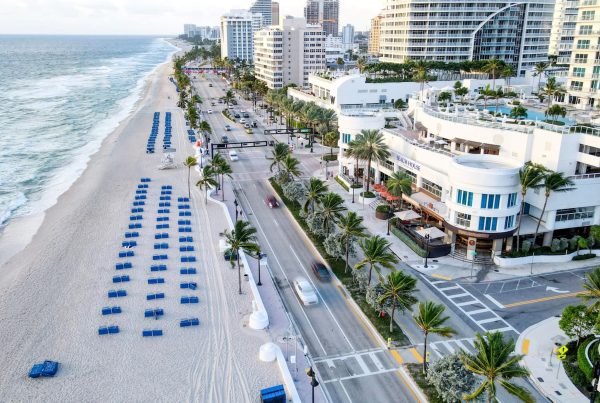Boca Raton almost certainly is a six-figure city.
I’m not referring to household income. Despite its affluence, the median is still about $76,000. The number refers to population. New estimates from the Census Bureau place Boca Raton’s 2018 population at 99,244. How the bureau can call such a precise figure an estimate puzzles me, but that’s the call as of last month.
Given recent growth, it would be a fairly safe bet that Boca Raton in mid-2019 has at least 100,000 residents. Those last 756 residents matter less than the milestone.
Boca Raton’s growth through the decade remains impressive, whether people like the growth or not. Despite a near-pause during the Great Recession, Boca Raton got 17.6 percent bigger between 2010 and 2018, based on the Census Bureau figures. The 2010 census had the population at 84,392. For the 2020 survey, the only question will be how far above 100,000 the population rises.
City council members and administrators don’t speak directly very often about this milestone, but they address it indirectly all the time. You hear it when Fire Chief Tom Wood talks about lower response times because his department is getting more calls. You hear it when council members wonder how the city will continue to provide “world-class services” without raising taxes.
Residents should not blame rising population on a conspiracy between developers and council members. Boca Raton doesn’t regularly approve projects that violate development rules. Indeed, the city has remained attractive because of tough standards. Its enviable commercial property tax base has enabled the city to finance amenities that especially now are drawing young families. Loss of population would be a much bigger challenge.
Still, growth brings another set of challenges. Like other cities, Boca Raton has imposed a fire fee, which really is away to raise more money without raising the actual tax rate. Boca Raton held the property tax rate firm during the recession, when revenue plunged. They brag now about not raising taxes, even though residents and business owners pay more each year because values rise.
In three years, Boca Raton will choose a new city manager. Leif Ahnell, who has held the job for 20 years, has placed himself on that firm retirement timetable. Ahnell’s specialty is finance. Other top administrators will near retirement age in the next five years.
Though milestones may be just numbers, Boca Raton is entering a new period as it becomes a six-figure city. With Ahnell’s retirement could come renewed talk of a strong-mayor form of government. If that change seems hard to consider, consider that in 1980 Boca Raton had about 50,000 people and some residents thought the city already had become too big. Bigger challenges could require new thinking.
Policy trickle-down
Republicans in Congress and President Donald Trump created another factor that will make Boca Raton attractive to wealthy Americans.
The 2017 tax bill capped the amount of state and local income taxes that are deductible on federal tax returns. Republicans added that provision in hopes of driving high-earning residents in high-tax states—many of them run by Democrats—to Florida and Texas, which don’t have state income taxes and are run by Republicans.
Penn-Florida is building the downtown Boca Raton luxury condo project whose residents will have privileges at the adjoining Mandarin Oriental Hotel. Last month, Penn-Florida hosted a panel on “tax migration to South Florida and the transformation of Boca Raton.”
According to a news release, one panelist said, “This migration is just getting started.” Another said, “If we compare a luxury product in New York City to a luxury product in Florida, it is easily one-third of the cost here.”
Perhaps the migration so far, as one panelist said, “is the tip of the iceberg.” Or it could last until a Democratic president and Congress change the tax laws.
City priorities set

The Boca Raton City Council has made its priorities for the coming budget year official.
Despite those looming financial and management issues, the council consensus is that the priorities should be: a “holistic approach” to traffic problems, school safety and further promoting the city as a center for business, technology and innovation.
It took the council two days at May’s goal-setting meetings and a follow-up discussion this month with the facilitator to agree on those priorities. For those understandably puzzling over the definition of “holistic approach” regarding traffic, it means taking as broad a look as possible. Something as small as adjusting traffic lights could help on Palmetto Park Road. Something as large as a $30 million project might be necessary to help Dixie Highway at rush hour.
This year, the city hired a different facilitator, hoping to make the goal-setting discussion less open-ended. Having attended the last six, I didn’t see much difference. Council members Monica Mayotte and Andrea O’Rourke, however, felt differently. O’Rourke called it “bigger picture” than previous years “yet more concise and directed.” Mayotte said council members were able to have “very constructive conversations.”
Florida’s Sunshine Law prohibits council members from discussing public business outside of public meetings. So it takes time for the meetings to hit common themes. But after listening to the annual presentations from department heads, I agree with Mayotte’s comment: “I don’t think the public realizes everything that goes on behind the scenes at the city.”
And Delray’s growth
Delray Beach continues to be no slouch when it comes to growth.
The Census Bureau estimates that the city added nearly 9,000 residents between 2010 and 2018, for a total of 69,358. By now, Delray Beach surely has topped 70,000, which is a milestone of its own. The rate of growth over those eight years was nearly 13 percent.
Because Delray Beach is between Boca Raton and Boynton Beach – which now has almost 80,000 residents—and can appear to be part of a separate market with Boca, we can lose perspective on its size. For perspective, Delray Beach is larger than Daytona Beach. There’s a thought for the next city manager, who will start this summer or fall.
Fire training at old Office Depot

While Delray Beach considers using Boca Raton’s fire training facility, the city for now will use the former Office Depot headquarters on Congress Avenue.
Developers will tear down the buildings to make way for a mostly residential project. So perhaps the site makes sense. At tonight’s meeting, the city commission will approve an agreement absolving the owner of any liability during the training, which will include, among other things: “Deploying hoselines and flowing water from the hydrant system, breaking windows on upper floors, breaching interior doors” and using “simulated smoke.” It sounds as if the city will be doing the developer a favor.
Clean & Cut
This is the second-to-last week of Boca Raton’s Clean & Cut Program, which the city began last year. In June, residents get an extra day of vegetation and bulk pickup. The extra day comes on a Saturday, when the city normally has no residential pickup. A city spokeswoman said the response this year has been “very good.”
The goal is to encourage homeowners to trim trees at the start of hurricane season. When Irma approached in September 2017, homeowners who had failed to trim promptly piled so much vegetation that city trucks couldn’t keep up with demand. Loose tree limbs pose hazards during high winds. Overgrown trees can bring down power lines, fall on neighbors’ property and uproot water lines.
Camino bridge opening delayed

Boca Raton residents had hoped that the Camino Real Bridge would reopen Thursday after the yearlong project to replace the city’s oldest span.
Instead, the bridge won’t open until at least mid-July. A city spokeswoman said continuing “mechanical and electrical” work delayed the opening. That information comes from the county, which owns the bridge and is supervising the project.
Road closures
Speaking of transportation, there will be many closures this week related to construction of a new overpass at the Palmetto Park Road interchange of I-95.
The road itself was closed Monday night. The entrance and exit ramps in both directions will be closed at night all week. The new bridge must support additional lanes as part of the project that will add two toll lanes in each direction.
This phase will extend the toll lanes from Southwest 10th Street in Deerfield Beach to just south of Glades Road with an estimated completion date of June 2022. The next phase will run to Linton Boulevard in Delray Beach. Atlantic Avenue in Delray Beach will have periodic closings as work continues on that I-95 interchange.
Clarification
I reported last week on the proposed public safety communications tower on the southeast corner of the Boca Raton municipal golf course. The city would own the tower.
In that post, I said the price of the tower would be $3 million. According to a city spokeswoman, the budgeted price is $2.2 million, but the agreement between the city and county—which would use the tower—notes that the price could be as much as $3 million.
The Palm Beach County Commission will decide on June 27 whether to approve the tower. Though Boca Raton owns the land—on Glades Road next to the Florida Turnpike—is in the county. GL Homes has a contract to buy the golf course and develop it.







